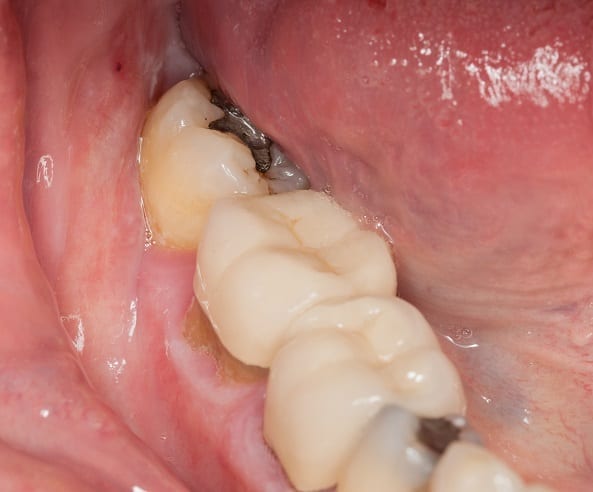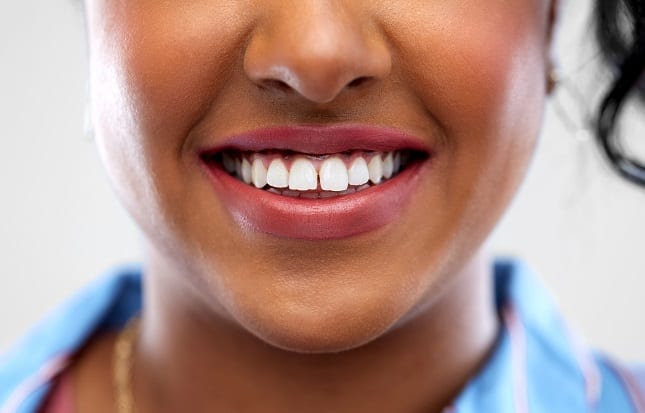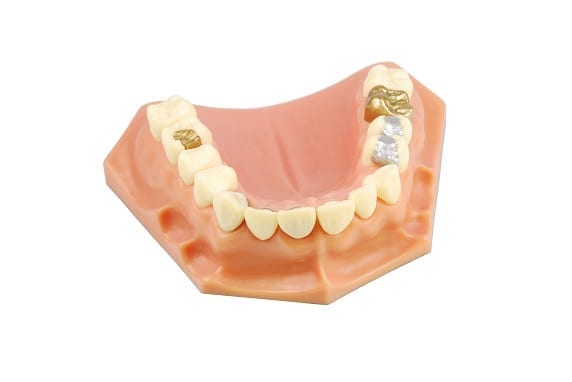A mercury filling, also known as a dental amalgam, is a type of tooth filling material that fills in holes due to dental caries or cavities. It’s made of mercury and other metals that are combined together to form a filling that is much tougher than regular composite resin filling.
It’s mostly used in molars or the back teeth since the greatest amount of bite force and wear down happens there. The technique has been in use for 100 years for millions of patients all over the world but it could’ve been in use as early as the Tang Dynasty in China.
Page Contents
Learn More about The Dental Amalgam Process
Dental amalgam is a mix of powdered metals contained within elemental liquid mercury. The metals consist of copper, silver, and tin. About half of this filling type by weight is made up of elemental mercury. The chemical properties of mercury enables it to react and bind together the metal powder of tin, copper, and silver into an amalgamate filling as though it’s metallic cement.
Here are a couple of other things you need to know about dental amalgam:
- Ingredient Percentages: Dental amalgam is typically composed of 50 percent mercury mixed with 22 to 32 percent silver, 14 percent tin, 8 percent copper, and other trace metals filling in for the remaining percentages.
- Silver Fillings: Dental amalgam is also known as silver fillings. This is because they’re silvery in appearance. However, despite its name, it’s actually an amalgamation of metals bound together by elemental mercury.
- Amalgam Putty: The dentist uses a capsule that contains liquid mercury and amalgam putty that’s shaped and put inside the hole in your tooth to fill in the dental pothole.
- Drilling and Shaping: A dentist first drills the tooth with the cavity before placing the silver filling. This is for the sake of removing the decay. The drill also shapes the hole in a way that allows smooth placement of the amalgam filling.
- Mixing The Amalgam Putty: The dentist then mixes the liquid mercury with the powdered alloy to form the amalgam putty under appropriate safety conditions and considerations. The components are provided in capsule form.
- Filling Placement: The soft putty filing is then placed into the tooth and shaped in the prepared hole. This then rapidly hardens into a solid filling that’s capable of withstanding the strong bite forces of the molars on the back of your mouth.
Frequently Asked Questions Regarding Amalgam Fillings

Here are the most burning questions of most patients inquiring about the safeness and viability of undergoing an amalgam filling operation.
- What do you need to know before getting this filling type? The choice of filling material used on your tooth decay and cavities depends on you as the patient, in tandem with your dentist. As a rule of thumb, tougher fillings like amalgam are used for molars and tooth-colored ones are used for incisors and canines.
You also have the alternative of getting a porcelain crown or using gold fillings in case you’re worried about the safeness of amalgam. The U.S. Food and Drug Administration (FDA) still approved dental amalgam but there’s an ongoing evaluation regarding its safety in accordance to all available information about it.
- What are the pros and cons of dental amalgam filling? Here are the benefits and drawbacks of dental amalgam.
- Pros:
- Strong
- Affordable
- Long-lasting
- Unlikely to break
- Perfectly safe according to the FDA
- Cons:
- Allergy risk
- Gray-colored
- Mercury poisoning risk
- Aesthetically unpleasant
- Risk of kidney, lung, and brain damage
The unique properties of mercury contributes quite a bit to the durability of the filling, such as its ability to bond with alloy powder and how its unmixed form is liquid at room temperature.
- How safe is amalgam? Millions of people all around the world have amalgam fillings. However, there are concerns regarding its health risks due to mercury vapor bioaccumulation. A number of studies on amalgam filling safety have been done for the better part of the 20th and 21st Centuries.
In 2009, the FDA evaluated this research and concluded that mercury-based amalgam fillings remains safe for use by children aged 6 years old and up and adults. It’s not recommended for children 5 years old and below and pregnant women. The European Union (EU), on the other hand, banned children under 15 years old to undergo amalgam-filling operations back in 2018.
- What is bioaccumulation? Bioaccumulation is the accumulation or steady build-up of a chemical in the tissues or organs of your body. One of the primary concerns of using mercury-bonded amalgamated alloys is that the mercury in them are bioaccumulative, as in the case of people eating fish who collect mercury inside their bodies as well.
Studies on amalgam fillings have shown that mercury vapor from the filling can accumulate into certain tissues of the body that includes the brain and kidneys. However, these studies don’t show that dental amalgam mercury bioaccumulation causes significant damage to targeted organs, which explains why the FDA still allows the use of amalgam filling by dentists in the U.S.
- Is mercury in amalgam the same as mercury found in certain fish species? No. Mercury has several chemical form variations. There’s elemental mercury used in dental amalgam. There’s also methylmercury or organic mercury and inorganic mercury. The form of mercury found in fish living in polluted rivers is methylmercury, which is a type of organic mercury.
The elemental mercury found in amalgam produces a mercury vapor that’s mainly absorbed by your lungs through inhalation. Meanwhile, methylmercury by fish are mainly absorbed by your digestive tract through fish consumption. Your body processes these different mercury types differently. Therefore, it has different levels of tolerance for either methylmercury or elemental mercury (vapor).
- What is the FDA’s stance on the safeness of mercury fillings? The low levels of mercury vapor linked from dental amalgam fillings are not cause of concern so far, according to the FDA. To be more specific, the FDA considers this filling type safe for use by children ages 6 years old and above and adults in light of scientific studies and evidence. There is no credible scientific evidence between adverse health effects and dental amalgam according to the clinical studies about the filling.
On one hand, there are concerns regarding the neurological systems in fetuses and very young children ages 5 years old and below in light of the neurotoxic effects of mercury. There’s limited to zero data about the long-term health effects of amalgam mercury vapors in pregnant women and their unborn child or children under 6 years old who are breastfed. On the other hand, the amount of mercury in breast milk linked to dental amalgam vapors is low. It also falls below the levels of oral intake that the Environmental Protection Agency (EPA) considers as safe.
- If you’re concerned about mercury vapors from amalgam fillings, should you get them removed? That’s up to you. On one hand, the FDA and EPA consider it as safe. On the other hand, if you wish to err on the side of caution, you can have them removed care of a dentist that offers amalgam filling removal and replacement with a mercury-free filling. According to the FDA, you don’t have to replace or remove your amalgam fillings if they’re in good condition and there’s no decay beneath it.
However, if there is damage or decay, you can request for a service to get you a safer type of dental restoration. As far as the FDA is concerned, removing perfectly fine and undamaged amalgam fillings can result in unnecessary tooth structure damage. This also exposes your body to additional mercury vapor as it’s released during the removal process. However, amalgam removal services typically have tubes and rubber dams available to keep mercury vapor release to a minimum.
A Brief History of Dental Amalgam

Here is the history of dental amalgam and why it went out of favor in recent years.
- 618-907 AD: Dental amalgam manufactured with tin and silver was first used in the Tang Dynasty of China. This is evidenced by medical text known as Xinxiu Bencao written by Su Gong in 659.
- 1505: Evidence of early dental amalgam in the text written by Liu Wentai during the Ming Dynasty states that it consists of 900 “shares” of tin, 45 “shares” of silver, and 100 “shares” of mercury.
- 1528: Germany stated using dental amalgam themselves, potentially getting the technology from China. They were known for their cheapness and easiness of use compared to gold fillings.
- 1826: England and France started using the dental amalgam mercury filling for dental purposes. Early amalgam fillings mixed the fillings of silver coins with mercury.
- 1833: The United States of America started using amalgam as well. However, it has become subject t to recurrent controversies in regards to the harmful effects of the mercury ingredient. Edward Crawcour and his nephew Moses brought it to the country.
- 1844: 50 percent of all dental restorations consisted of amalgam in upstate New York. However, the American Society of Dental Surgeons (ASDS) denounced the use of the filling type due to mercury poisoning concerns. They forced members to sign a pledge to abstain from using the fillings. ASDS also declared usage of the filling as malpractice.
- 1856-1859: ASDS was disbanded in 1856 and the National Dental Association (NDA) was founded in its place in 1859. The NDA defended the use of dental amalgam compared to the older association. They claimed that it’s safe from a health standpoint and the mercury content was too miniscule to cause sickness. The NDA later on became the American Dental Association (ADA).
- 1926: Alfred Stock—a German chemist—discovered that his health problems were caused by mercury in his amalgam fillings. After getting them removed, he then studied the health problems of his other colleagues, advising them to have their fillings taken off as well.
He specifically studied the release of mercury vapors from the fillings and published his findings in over 30 scientific papers. He was one of the major voices against amalgam filling use of his time.
- 1930s: Before the anti-amalgam movement got its legs, Stock’s laboratory and most of his records were destroyed because of a bombing raid during the early parts of the Second World War.
- 1990: 60 Minutes from CBS did an exposé on the hazard of dental amalgams back in December 16, 1990. The host, Morley Safer, interviewed scientists Boyd Hely, Lars Friberg, Murray Vimy, and Fritz Lorscheider. The host also did interviews with an ADA spokesman in regards to the controversy and the attacks of U.S. state dental licensing boards on holistic dentists who do mercury-free fillings.
- 1994-1996: According to autopsies on babies who died from Sudden Infant Death Syndrome (SIDS) published by G. Drasch and others at Germany’s University of Munich, there’s a strong link between mercury levels in the kidneys and brains of babies and the number of amalgam fillings in the mother’s teeth.
- Lutz confirmed these findings in 1996 on his own autopsies covering SIDS in babies. Soon after, the German government curbed the use of amalgam of women of childbearing age and children.
- 1995-1996: A report for Health Canada by G. Mark Richardson, Ph.D. was released on mercury exposure from amalgam filings. According to the report, amalgams contribute about 50 percent or more of an adult’s mercury exposure, thus presenting an unacceptable risk.
He recommended to Health Canada to ban the filling. The board then established in 1996 certain guidelines to Canadian dentists that discourage them to use amalgams on pregnant women, children, and persons with kidney disorders, among other vulnerable persons.
- 2018: In July 2018, the EU banned amalgam treatment for children under 15 years old. Breastfeeding women were also advised against using them.
Is Dental Amalgam Safe or Not?

Although mercury-based dental amalgam fillings remain approved by the FDA, there’s currently a movement in the dental community to not use them and, instead, favor of composite resin fillings.
Regardless, it’s still in use and available in many clinics out there. There are also dentist clinics that offer dental amalgam removal to fulfill the needs of people who are concerned about the miniscule amounts of mercury vapor that end up in their system after being released by the filling type. For such people who are worried about mercury poisoning, various clinics offer alternative options and services that can allay their fears.
Thantakit International Dental Center is Thailand’s longest established dental center. Situated in Bangkok, our clinic is renowned across the world as a destination for world-class dentistry, with most of our patients flying to us from Australia.
Click here to learn about safe mercury fillings removal at Thantakit International Dental Center.
Please contact us today and get a FREE dental consultation.












